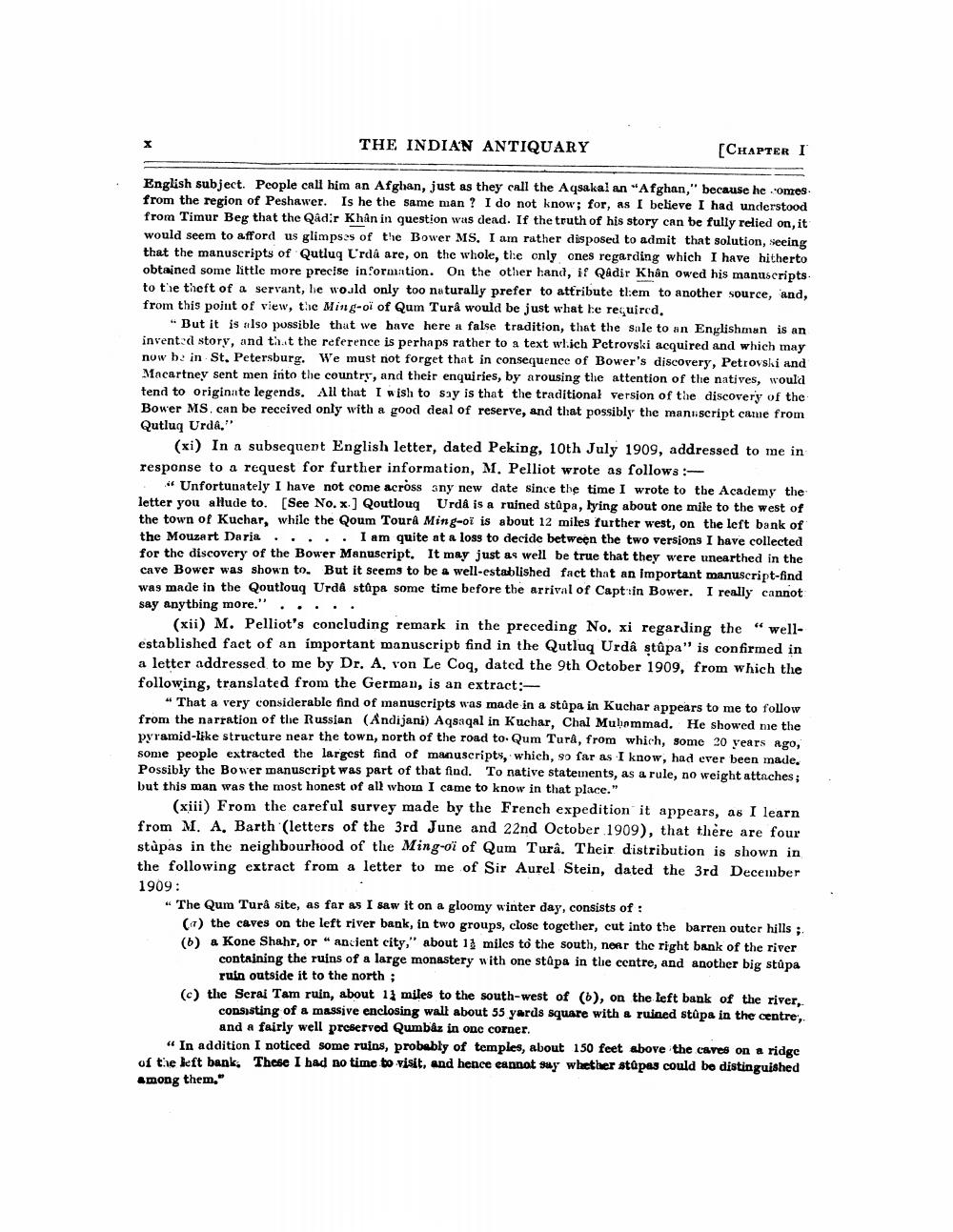________________
THE INDIAN ANTIQUARY
[CHAPTER I
English subject. People call him an Afghan, just as they call the Aqsakal an "Afghan," because he comes from the region of Peshawer. Is he the same man? I do not know; for, as I believe I had understood from Timur Beg that the Qadir Khan in question was dead. If the truth of his story can be fully relied on, it would seem to afford us glimpses of the Bower MS, I am rather disposed to admit that solution, seeing that the manuscripts of Qutluq C'rda are, on the whole, the cnly ones regarding which I have hitherto obtained some little more precise information. On the other hand, if Qadir Khân owed his manuscripts to the theft of a servant, he would only too naturally prefer to attribute tl:em to another source, and, from this point of view, the Ming-oi of Qum Turå would be just what be required.
* But it is also possible that we have here a false tradition, that the sale to an Englishman is an invented story, and that the reference is perhaps rather to a text wl.ich Petrovski acquired and which may now b. in St. Petersburg. We must not forget that in consequence of Bower's discovery, Petrovski and Macartney sent men into the country, and their enquiries, by arousing the attention of the natives, would tend to originate legends. All that I wish to say is that the traditional version of the discovery of the Bower MS. can be received only with a good deal of reserve, and that possibly the manuscript came from Qutlug Urda."
(xi) In a subsequent English letter, dated Peking, 10th July 1909, addressed to me in response to a request for further information, M. Pelliot wrote as follows:
if Unfortunately I have not come across any new date since the time I wrote to the Academy the letter you allude to. [See No.x] Qoutloug Urdå is a ruined stúpa, tying about one mile to the west of the town of Kuchar, while the Qoum Toura Ming-oi is about 12 miles further west, on the left bank of the Mouzart Daria ..... I am quite at a loss to decide between the two versions I have collected for the discovery of the Bower Manuscript. It may just as well be true that they were unearthed in the Cave Bower was shown to. But it seems to be a well-established fact that an important manuscript-find was made in the Qoutloug Urdâ stúpa some time before the arrival of Capt in Bower. I really cannot say anything more." .....
(xii) M. Pelliot's concluding remark in the preceding No. xi regarding the “ wellestablished fact of an important manuscript find in the Qutluq Urdå stúpa" is confirmed in a letter addressed to me by Dr. A. von Le Coq, dated the 9th October 1909, from which the following, translated from the German, is an extract:
4 That a very considerable find of manuscripts was made in a stapa in Kuchar appears to me to follow from the narration of the Russian (Andijani) Aqsaqal in Kuchar, Chal Muhammad. He showed me the pyramid-like structure near the town, north of the road to. Qum Turå, from which, some 20 years ago, some people extracted the largest find of manuscripts, which, so far as I know, had ever been made. Possibly the Bower manuscript was part of that find. To native statements, as a rule, no weight attaches; but this man was the most honest of all whoin I came to know in that place."
(xiii) From the careful survey made by the French expedition it appears, as I learn from M. A. Barth (letters of the 3rd June and 22nd October 1909), that there are four stùpas in the neighbourhood of the Ming-oï of Qum Turâ. Their distribution is shown in the following extract from a letter to me of Sir Aurel Stein, dated the 3rd December 1909:
The Qum Turå site, as far as I saw it on a gloomy winter day, consists of: (a) the caves on the left river bank, in two groups, close together, cut into the barren outer hills; (b) a Kone Shahr, or "ancient city," about 10 miles tò the south, norr the right bank of the river
containing the ruins of a large monastery with one stūpa in the centre, and another big stúpa
ruin outside it to the north ; (c) the Serai Tam ruin, about 13 miles to the south-west of (o), on the left bank of the river,
consisting of a massive enclosing wall about 55 yards square with a ruined stupa in the centre,
and a fairly well preserved Qumbaz in one corner “ In addition I noticed some ruins, probably of temples, about 150 feet above the caves on a ridge of the left bank. These I had no time to visit, and hence cannot say whether stupas could be distinguished among them."




